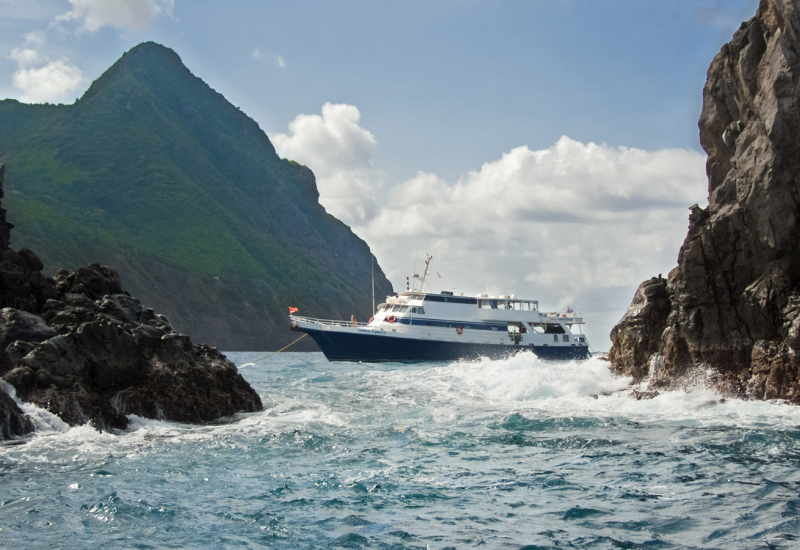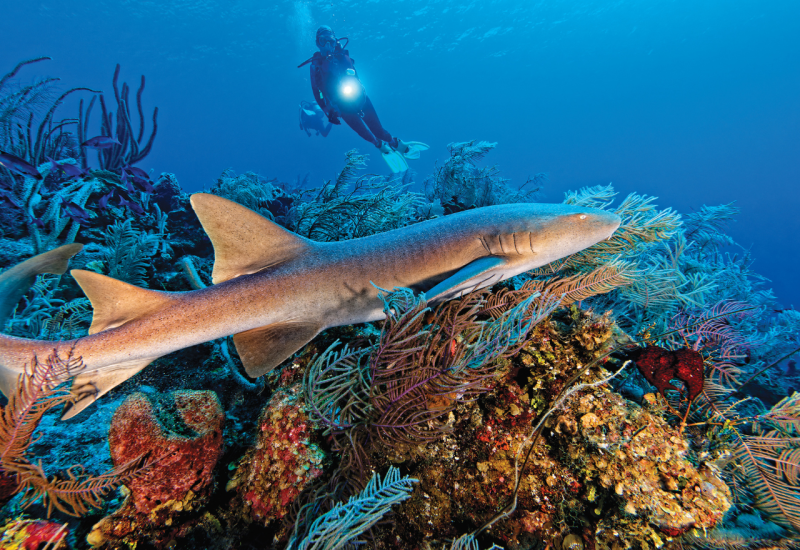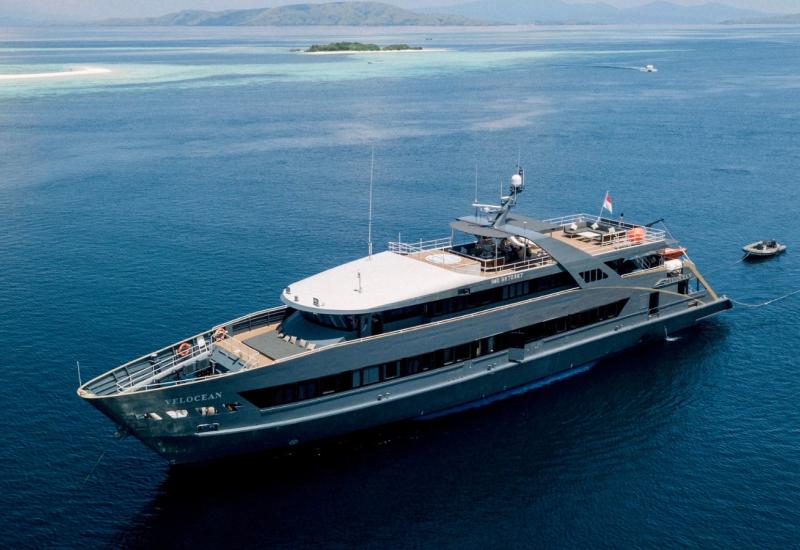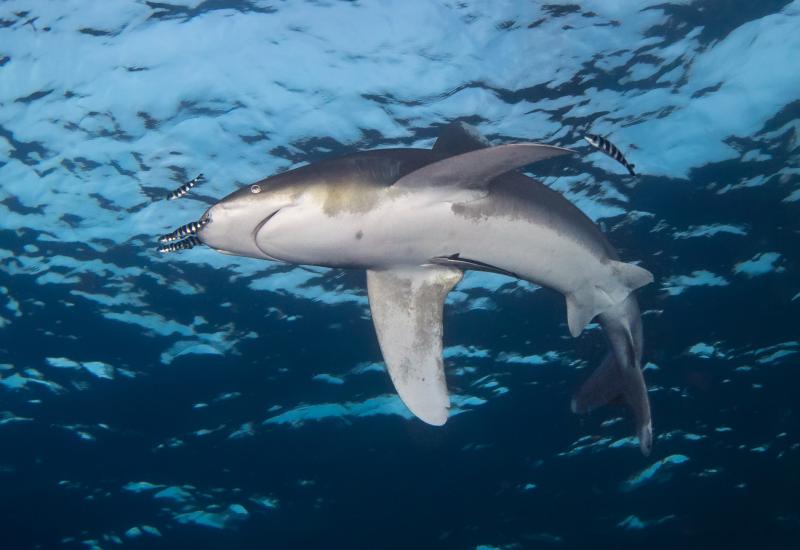Belize Liveaboard Diving on the Sun Dancer II

Live-Aboard: Belize and the Sun Dancer II
Ethan Daniels
All Aboard the Belize Sun Dancer II
I have never played god before, and I’m scared by how much I like it. Given the dozen dive lights trained on the reefs below, it seems many of us are relishing the rush of tarpons speeding like bullet trains mere inches from our masks, attacking prey. Our lights stun the smaller fish — they freeze like deer in headlights, easing the predators’ work.
The first hapless damsel in my beam was an accident. Numbers two, three and four reveal my possible mean streak. Or perhaps the excitement is too hard to resist. I spend much of the dive at Uno Coco mesmerized, despite what else lurks on these reefs. On previous night dives from Belize’s Sun Dancer II, we’ve followed free-swimming morays and octopuses wiggling through crevices, hungry to strike.
Thrill-seekers will welcome a week aboard the Dancer Fleet’s 138-foot-long vessel Sun Dancer II that travels to the outer atolls beyond the reach of most day boats. The five-and-a-half diving days are spent along sheer walls interrupted by sand channels, serving as freeway exit points for cruising pelagics, including eagle rays, Caribbean reef sharks and more.
It’s laughable how frequent the sightings are. Two friends had spread out along the reef as they followed the guide— one had spotted an eagle ray, and another noticed a shark. Swimming toward each other, each had been struggling to get the other’s attention, until the eagle ray crossed paths with the shark and each realized what the other had been so excited about.
Like them, I’m a fan of the bigger stuff, but many divers, especially the photographers, drain their tanks in the shallows. There it’s a longer, more-relaxing experience where smaller critters such as longhorn nudibranchs, sailfin blennies and hundreds of rosy razorfish dwell. Either way, it’s hard not to appreciate the 100 feet or more of visibility and reefs packed with color.
When my gauge announces it’s time, I head toward the impossible-to-miss white strobe. Gear off, I enjoy a quick, hot, on-deck shower, stepping out just as instructor Megan O’Meara wraps a towel hot from the dryer around me and rubs my shoulders. It’s just one perk of an experience designed to remove any work or stress on your part.
Hate setting an alarm? Just mark the tag on your stateroom door: Choose what time you’d like coffee, and how you take it. Not great at spotting critter lairs? Before each dive, an instructor carefully maps the highlights. And if you’re lucky, they’ll even imitate the sounds, as Karim Fuller does, recreating the whitespotted toadfish’s throaty “erp, erp, erp” so we’ll know exactly what to listen for.
BELIZE DIVE GUIDE
As far as underwater touchdown dances go, Steffen Binke’s is pretty memorable. My dive buddy wildly egg-beats his fists, signaling he scored the eagle ray mug shot he’d been working toward all week. Previous attempts called for every bit of restraint to keep from triggering the shutter too soon and possibly frightening the subject — but he still hadn’t had the perfect approach.
Before this dive, he’d sat down with Fuller, who’d advised him to study the animal’s flight patterns. And so Binke stalked in the sand channels for 55 minutes, noting where the animal doubled- back with each loop. Voilà!
“It’s like kicking a goal,” the Germanyborn Binke says later. “You play all game, and win at the last minute.”

The Belize Barrier Reef, like Australia’s Great one, lies far enough offshore that it’s largely protected from development run-off, excessive visitors and other reef stresses. Lighthouse Reef and Turneffe atolls remain among the Caribbean’s healthiest — where the size of the hard corals is as impressive as the colors.
Reefs aside, the smaller critters are among the more unusual, and the pelagic encounters are some of the longest and most frequent. After a few days of diving in the open blue, you learn to sense something approaching — that flutter of excitement is almost as rewarding as the encounter itself.
Even the boat seems to attract magic. At many anchorages, fat swarms of chubs collect beneath the hull. These fish don’t mind visitors, allowing us to fall in among their ranks. And as much as Belize excites, it also calms: There is something undeniably Zen about swimming among a school.
I don’t typically drain tanks on a liveaboard: I know that with as many as five dives a day, I will get my fill. Plus, there’s always a snack waiting, be it warm brownies or flatbread pizzas. But here in Belize, I can’t help but make the most of every fill, especially when even the boat’s underside is a hotbed of fins. As I gravitate toward my happy place, if it wouldn’t scare off what I’m there to see, I would surely punch out my own touchdown dance.
NEED TO KNOW:
When to Go: Sun Dancer II (http://www.dancerfleet.com/) cruises the same atolls year-round. Note that if you travel in April and May, you can arrange to see whale sharks off the Placencia coast at Gladden Spit Marine Reserve. Come June through September, you can see these dotted giants north, off Mexico’s Isla Mujeres.
Dive Conditions: March through May brings the best visibility. Occasionally, December and January see rougher seas and mild currents. Like much of the Caribbean, Belize’s water temperatures vary from 79 to 84 F, with the higher temperatures in summer. Expect visibility from 50 to 110 feet.
Operator: The 138-foot-long vessel accommodates up to 20 guests in 10 staterooms. A crew of eight ensures that meals, full tanks, clean rooms and hot towels are always waiting for you.
Price Tag: The Saturday-to-Saturday charter starts at $2,195 per person, which does not include a $95 port charge and $15 recompression-chamber support fee. Upgrade all tanks to nitrox for $100.

FIVE REASONS TO DIVE BELIZE:
1 Wall Diving: Nearly every site along Lighthouse Reef and Turneffe atolls is a wall, which is great for dramatic views, pelagic sightings and easy navigation.
2 The Blue Hole: Just as the Grand Canyon ranks high for most sightseers, so too does this landmark for divers. Provided conditions allow, you can check this baby off your list while aboard Sun Dancer II.
3 Food: Most tropical-destination live-aboards import produce, whereas the Sun Dancer II takes advantage of local pineapple, melon and other delights. Seafood fans will appreciate the locally caught fish. Everything on chef Jerry Carcamo’s menu — from the barbecue to the fish curries — warrants second helpings, but you won’t want to miss his award-winning apple bread.
4 Whitespotted toadfish: This critter might not have been on your wish list, but it will be once you see its whiskered mug. Belize has an abundance of macro, from crabs to nudis, so be sure to study the wire corals and other rich habitats.
5 Jungle Add-on: If you like thrills such as rappelling, caving and river tubing, book time in the interior.

Ethan Daniels
All Aboard the Belize Sun Dancer II
I have never played god before, and I’m scared by how much I like it. Given the dozen dive lights trained on the reefs below, it seems many of us are relishing the rush of tarpons speeding like bullet trains mere inches from our masks, attacking prey. Our lights stun the smaller fish — they freeze like deer in headlights, easing the predators’ work.
The first hapless damsel in my beam was an accident. Numbers two, three and four reveal my possible mean streak. Or perhaps the excitement is too hard to resist. I spend much of the dive at Uno Coco mesmerized, despite what else lurks on these reefs. On previous night dives from Belize’s Sun Dancer II, we’ve followed free-swimming morays and octopuses wiggling through crevices, hungry to strike.
Thrill-seekers will welcome a week aboard the Dancer Fleet’s 138-foot-long vessel Sun Dancer II that travels to the outer atolls beyond the reach of most day boats. The five-and-a-half diving days are spent along sheer walls interrupted by sand channels, serving as freeway exit points for cruising pelagics, including eagle rays, Caribbean reef sharks and more.
It’s laughable how frequent the sightings are. Two friends had spread out along the reef as they followed the guide— one had spotted an eagle ray, and another noticed a shark. Swimming toward each other, each had been struggling to get the other’s attention, until the eagle ray crossed paths with the shark and each realized what the other had been so excited about.
Like them, I’m a fan of the bigger stuff, but many divers, especially the photographers, drain their tanks in the shallows. There it’s a longer, more-relaxing experience where smaller critters such as longhorn nudibranchs, sailfin blennies and hundreds of rosy razorfish dwell. Either way, it’s hard not to appreciate the 100 feet or more of visibility and reefs packed with color.
When my gauge announces it’s time, I head toward the impossible-to-miss white strobe. Gear off, I enjoy a quick, hot, on-deck shower, stepping out just as instructor Megan O’Meara wraps a towel hot from the dryer around me and rubs my shoulders. It’s just one perk of an experience designed to remove any work or stress on your part.
Hate setting an alarm? Just mark the tag on your stateroom door: Choose what time you’d like coffee, and how you take it. Not great at spotting critter lairs? Before each dive, an instructor carefully maps the highlights. And if you’re lucky, they’ll even imitate the sounds, as Karim Fuller does, recreating the whitespotted toadfish’s throaty “erp, erp, erp” so we’ll know exactly what to listen for.
BELIZE DIVE GUIDE
As far as underwater touchdown dances go, Steffen Binke’s is pretty memorable. My dive buddy wildly egg-beats his fists, signaling he scored the eagle ray mug shot he’d been working toward all week. Previous attempts called for every bit of restraint to keep from triggering the shutter too soon and possibly frightening the subject — but he still hadn’t had the perfect approach.
Before this dive, he’d sat down with Fuller, who’d advised him to study the animal’s flight patterns. And so Binke stalked in the sand channels for 55 minutes, noting where the animal doubled- back with each loop. Voilà!
“It’s like kicking a goal,” the Germanyborn Binke says later. “You play all game, and win at the last minute.”

The Belize Barrier Reef, like Australia’s Great one, lies far enough offshore that it’s largely protected from development run-off, excessive visitors and other reef stresses. Lighthouse Reef and Turneffe atolls remain among the Caribbean’s healthiest — where the size of the hard corals is as impressive as the colors.
Reefs aside, the smaller critters are among the more unusual, and the pelagic encounters are some of the longest and most frequent. After a few days of diving in the open blue, you learn to sense something approaching — that flutter of excitement is almost as rewarding as the encounter itself.
Even the boat seems to attract magic. At many anchorages, fat swarms of chubs collect beneath the hull. These fish don’t mind visitors, allowing us to fall in among their ranks. And as much as Belize excites, it also calms: There is something undeniably Zen about swimming among a school.
I don’t typically drain tanks on a liveaboard: I know that with as many as five dives a day, I will get my fill. Plus, there’s always a snack waiting, be it warm brownies or flatbread pizzas. But here in Belize, I can’t help but make the most of every fill, especially when even the boat’s underside is a hotbed of fins. As I gravitate toward my happy place, if it wouldn’t scare off what I’m there to see, I would surely punch out my own touchdown dance.
NEED TO KNOW:
When to Go: Sun Dancer II (http://www.dancerfleet.com/) cruises the same atolls year-round. Note that if you travel in April and May, you can arrange to see whale sharks off the Placencia coast at Gladden Spit Marine Reserve. Come June through September, you can see these dotted giants north, off Mexico’s Isla Mujeres.
Dive Conditions: March through May brings the best visibility. Occasionally, December and January see rougher seas and mild currents. Like much of the Caribbean, Belize’s water temperatures vary from 79 to 84 F, with the higher temperatures in summer. Expect visibility from 50 to 110 feet.
Operator: The 138-foot-long vessel accommodates up to 20 guests in 10 staterooms. A crew of eight ensures that meals, full tanks, clean rooms and hot towels are always waiting for you.
Price Tag: The Saturday-to-Saturday charter starts at $2,195 per person, which does not include a $95 port charge and $15 recompression-chamber support fee. Upgrade all tanks to nitrox for $100.

FIVE REASONS TO DIVE BELIZE:
1 Wall Diving: Nearly every site along Lighthouse Reef and Turneffe atolls is a wall, which is great for dramatic views, pelagic sightings and easy navigation.
2 The Blue Hole: Just as the Grand Canyon ranks high for most sightseers, so too does this landmark for divers. Provided conditions allow, you can check this baby off your list while aboard Sun Dancer II.
3 Food: Most tropical-destination live-aboards import produce, whereas the Sun Dancer II takes advantage of local pineapple, melon and other delights. Seafood fans will appreciate the locally caught fish. Everything on chef Jerry Carcamo’s menu — from the barbecue to the fish curries — warrants second helpings, but you won’t want to miss his award-winning apple bread.
4 Whitespotted toadfish: This critter might not have been on your wish list, but it will be once you see its whiskered mug. Belize has an abundance of macro, from crabs to nudis, so be sure to study the wire corals and other rich habitats.
5 Jungle Add-on: If you like thrills such as rappelling, caving and river tubing, book time in the interior.










